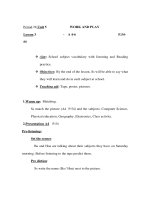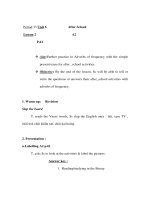Giáo án anh văn lớp 12 - UNIT3: WAYS OF SOCIALISING - LESSON 2: speaking pps
Bạn đang xem bản rút gọn của tài liệu. Xem và tải ngay bản đầy đủ của tài liệu tại đây (29.6 KB, 5 trang )
UNIT3: WAYS OF SOCIALISING
LESSON 2: speaking
1. Objectives:
a.Educational aim :
b.knowledge:
2. Teaching aids:
3. Procedure:
Tim
e
Steps - contents Teacher’s acts Students’acts
I. Warm – up :
Put the words below into the right
columns.
Nice, terrible, great, lovely, dirty, decent,
worse, better, wonderful, modern, out of
date, fashionable.
* Positive meaning * Negative
meaning
Give the poster
Call sts to put words
in columns
Give feedback and
elicit sts to give
meaning of words
Do the task
Reading words,
present meaning of
words.
II. Pre-task
1. Task1: Practise reading the dialogue.
Phil: You really have a beautiful blouse,
Barbara, I’ve never seen such a perfect
thing on you.
Barbara: Thank you, Phil. That’s a nice
compliment.
Peter: Your hairstyle is terrific, Cindy.
Cindy: Thanks, Peter. I think I’ve finally
found a style thatlooks decent and is
easy to handle.
Tom: I thought your tennis game was a
lot better today, Tony.
Tony: You’ve got to be kidding! I
thought it was terrible.
Some common ways of compliments
and responses:
-What a/an………… you have/ have
got!
-How + adj/adv………………… !
-You really have…………………….
Read the dialogue in
model, ask sts to
practice it
Indicate some pairs to
read the dialogues.
Elicit sts to point out
some ways of making
compliment and
response.
Present some
common
compliments and
responses.
Practise reading the
dialogues.
Point out the ways of
giving compliments
and responses.
Take notes
-
Your …………… is/are…………
* responses
I’m glad you like it.
Thank you. I think/ thought……………
Thank you. That’s a nice compliment.
You must
have got to be kidding.
2. Task2: Practise giving compliments to
suit the response. Use the cues below.
Suggested answers:
- What a nice dress you have got! I really
like it.
- Your motorbike looks really
wonderful.
- I thought your badminton playing was
great. It has improved quickly.
Task3: Practise responding
Expected answers:
- Thank you, Phil. I think you can do it
as well as I do.
- Thank you, Peter. That’s a nice
Ask for pairworks
Elicit
Give feedback
Ask sts to work in
pairs
And present the
results.
Evaluate/ give
Working in pairs
Reading/ presenting
the results.
Working in pairs
Present the answers
Practice reading the
dialogue.
compliment.
- You must be kidding. I think it is
acceptable.
Task4:
Expected answers:
A nice pair of glasses:
A: Your pair of glasses are really nice. I
really like them.
B: Really, Peter. I just bought it
yesterday.
A new and expensive watch;
A: You really have a new and expensive
watch, ……… How did you get it?
B: Thank you, ……… My father bought
it for me on my birthday.
A new cell phone:
A: Your new cell phone looks great. I
have never seen such a nice one before.
B: Thanks. I finally found a suitable one
for me.
IV. Post task
feedback
Ask sts to work in
pairs, then exchange
with the others.
Elicit sts
Evaluate sts’s
answers
Work in pairs
Share with the other
pairs.
Present the dialogues
Take note teacher’s
feedback.
Work with friends,
practice speaking,
using the given cues.
Work with your friends: Make
compliments and responses about
something or performances of your
friends in class.
- study
- speaking English
- singing
- briefcase/ a new pen/ a nice hat/
V. Homework:
Practise giving compliments and
responses about something
Give cues, ask sts to
practice giving
compliments and
responses
Present the results









